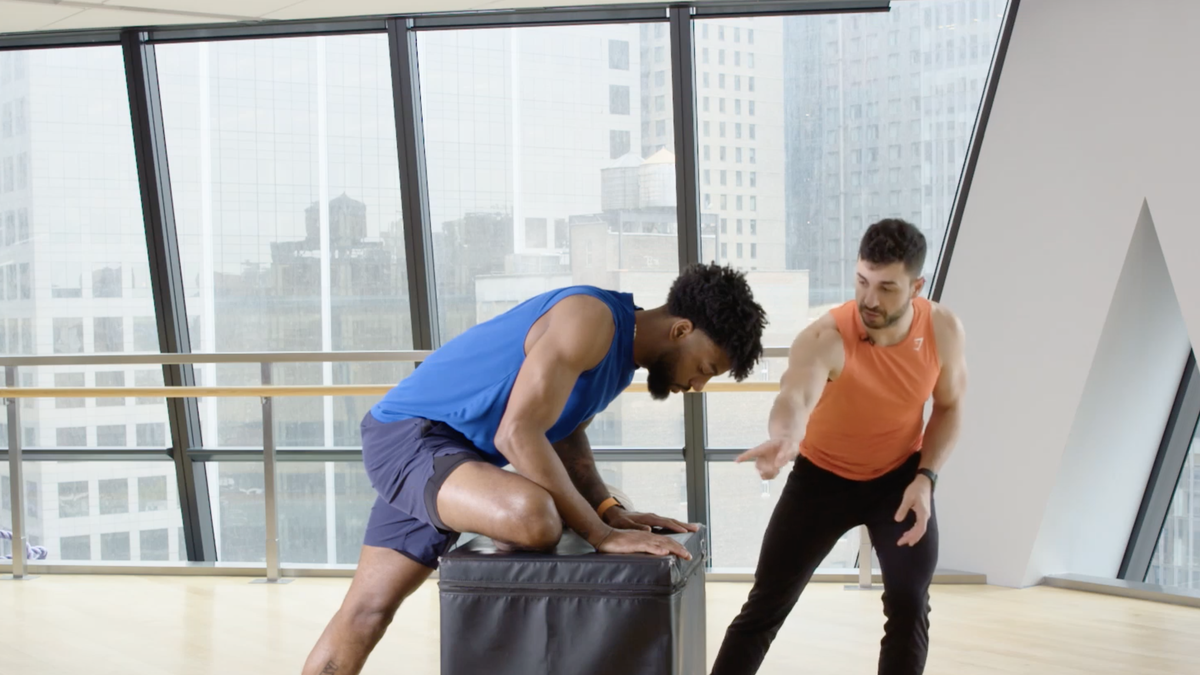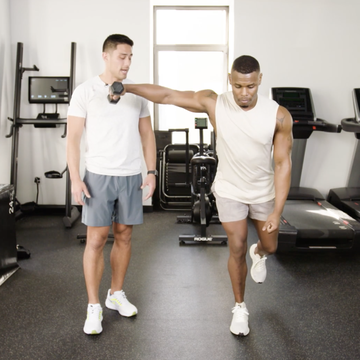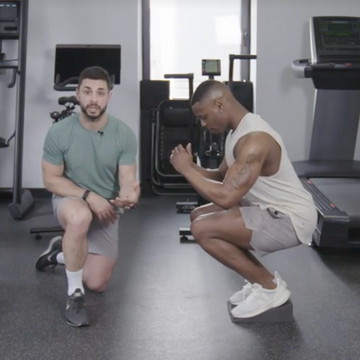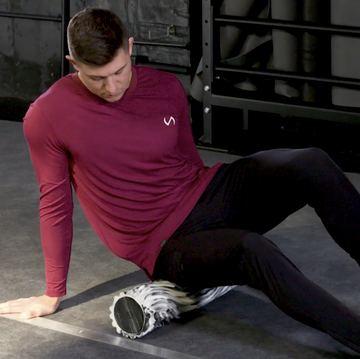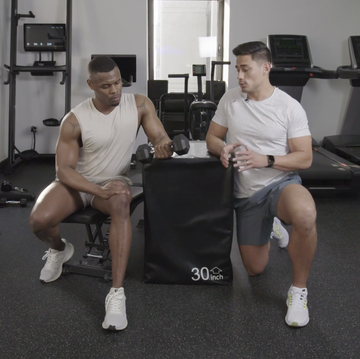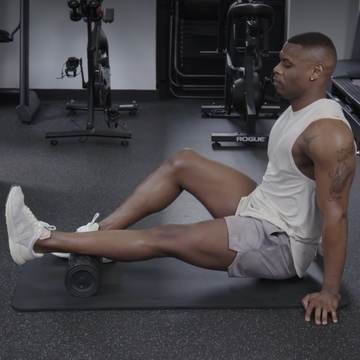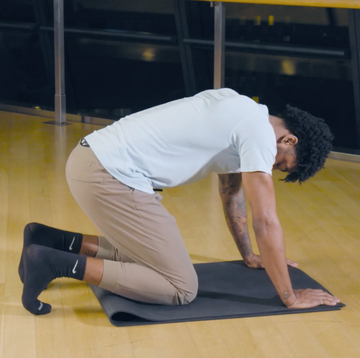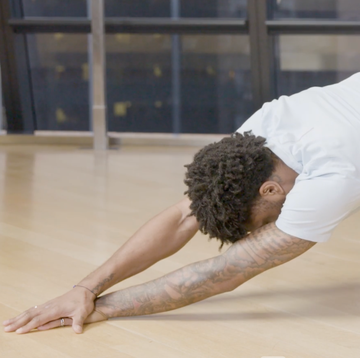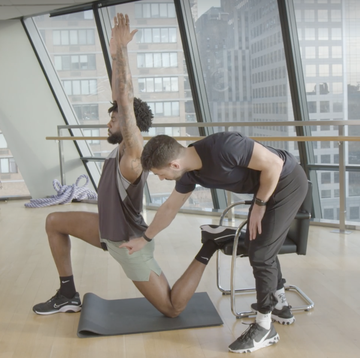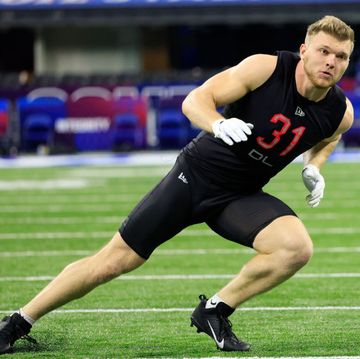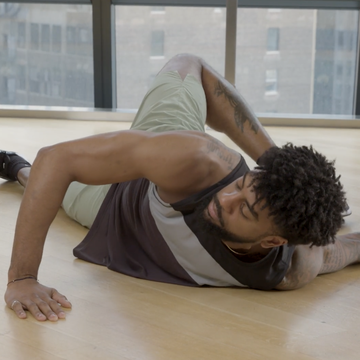ARE YOU FEELING tightness on the outside of your hip?
The culprit may be the glute medius, the middle portion of your glute muscle triad. This muscle takes on a large portion of the pressure applied through the hip, making it an important player in your hip stability and strength.
"Any time you're in that single leg stance position, that glute medius muscle is going to be absorbing most of that pressure through that area," says physical therapist Daniel Giordano, DPT, PT, C.S.C.S. of Bespoke Treatments in New York City.
This pain might be familiar to you if you typically execute single-leg movements, such as running or stair climbing. You might also understand the struggle if you commonly incorporate unilateral lifts, like Bulgarian split squats or single-leg deadlifts, into your strength training plan. When the muscle tires out, it can become tight and sore.
Here, Giordano and Vaughn Gray, CPT, share a handful of stretches designed to fix this issue by alleviating any tension you may hold in the glute medius.
What Is the Glute Medius?
The gluteus medius is the middle of the three glute muscles, nestled between the gluteus minimus and the gluteus maximus. The muscle begins at the top of your pelvis bone and inserts into the upper portion of your femur, or thigh bone.
What Does the Glute Medius Do?
The glute medius is most responsible for abducting the leg (pulling the leg laterally away from the midline of the body). The muscle also assists in medial-lateral rotation of the leg, Giordano says. It absorbs a significant amount of pressure that is applied when doing single-leg impact movements, which is why you might feel extra tension in the muscle if you frequently do unilateral lifts.
Who Should Do Glute Medius Stretches?
Stretching is good for everyone, but these stretches will be especially help you loosen up if you're feeling extra tight in your hips. Give these moves a try if that tension is hindering the flow of your everyday movement. They will help to release some of that pent up stress and get you back to moving normally again.
4 Stretches Glute Medius Stretches
Sitting Figure 4 Stretch
You can perform this stretch just about anywhere, making it a great go-to for when you're feeling tight, Giordano says. This will emphasize a stretch on the lateral portion of the glute.
How to Do It:
- Sit on a chair or a box, and cross one ankle over top of the other knee.
- Push down the knee of the leg that is crossed, and slowly start leaning forward until you feel a stretch on the outside of that hip.
- Hold that stretch for about 5 to 10 seconds before releasing. Repeat that 10 times.
Elevated Pigeon Stretch
If you're a yogi, you're probably familiar with the pigeon stretch. We're going to elevate it up off the ground to get a little deeper. You'll need an elevated surface for this one. A box, bench, or table all work well.
How to Do It:
- Bring your lower leg up onto the box. Your heel should square up to your opposite hip.
- Move the planted leg back a step, and lean your weight forward. Pause once you feel a stretch.
- Hold that stretch for about 5 to 10 seconds before releasing. Repeat that 10 times.
Posterior Capsule Stretch
If your tightness feels a little deeper than the glute, this stretch can help. "This is a great way to get the lateral aspect of that glute, where the glute medius is, as well as the posterior outside capsule of that hip," Giordano says.
How to Do It:
- Start in the quadruped position. Cross one leg behind the other, stretching as far as you can diagonally.
- Relax the foot and the knee of that leg into the floor, and lean your weight into the non-crossed leg. Lean until you feel a stretch through the side of your glute.
- Hold that stretch for about five to 10 seconds before releasing. Repeat that 10 times.
Sitting Glute Medius Stretch
This is another stretch that is great to add in anywhere you might be. Start your day by doing it in bed, or take a break from work and do it on the floor.
How to Do It:
- Start by sitting on the ground with both legs straightened out in front of you.
- Take one leg and cross it over the other. Pull that knee into your chest.
- Hold that stretch for about five to 10 seconds before releasing. Repeat that 10 times.
Glute Medius Foam Roll
Foam rolling will help increase blood flow to the glute medius muscle to help relieve tightness, Giordano says.
How to Do It:
- Sit on your foam roller, and cross one ankle overtop of the other knee, coming to that figure four position.
- Lean into the leg that is crossed over. Move your weight up and down, and left to right into the foam roller.
- This shouldn't hurt, and if it does, offload some of the pressure you're applying.
- Perform this for about 30 to 60 seconds, twice a day.
For more advice from physical therapists to help you move and feel better, check out all of our guides in The Fix series.
Cori Ritchey, NASM-CPT is an Associate Health & Fitness Editor at Men's Health and a certified personal trainer and group fitness instructor. You can find more of her work in HealthCentral, Livestrong, Self, and others.
Brett Williams, a fitness editor at Men's Health, is a NASM-CPT certified trainer and former pro football player and tech reporter who splits his workout time between strength and conditioning training, martial arts, and running. You can find his work elsewhere at Mashable, Thrillist, and other outlets.
